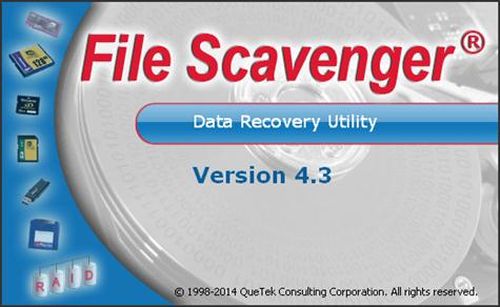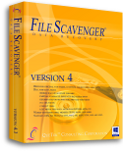 | |
QueTek Consulting Corporation of Houston, Texas is a software development company specializing in affordable data recovery utilities for PCs running Microsoft Windows. Our hard drive data recovery software can retrieve lost files even if the hard drive partition is corrupt or the drive is detected by the PC hardware but not recognized by Windows®. We also offer recovery services for failed NAS and SAN systems, RAIDs and spanned volumes for Windows and Linux. |
 |
| |
 File Scavenger® Version 4.3 File Scavenger® Version 4.3 |
| |
|
|
Platforms |
Windows® 10, 8, 7, Vista, Server
2012/2008/2003, XP and 2000. |
|
Media |
Hard disks, memory cards, flash drives,
RAID, RAIDZ, NAS and more. |
|
Types of files |
All file types. |
|
Causes of data loss |
Accidental file
deletion. Removal from Recycle
Bin, network
drive.
Unbootable computer.
Drive restored to
factory settings.
Corrupted drive. Reformatted or deleted partition.
Crashed drive. Undetected drive.
Drive hanging, dropping offline
intermittently.
Failed RAID, spanned,
or NAS volume. |
|
Recovered information |
Original filename, contents, folder path and
dates. |
|
File systems |
NTFS, FAT 32/16/12, exFAT, ReFS,
ext3, ext4, HFS+, HFSX, UFS1, UFS2, XFS, ZFS/RAID-Z,
VMFS, VMDK, VHD and VHDX. |
|
Languages |
English, Chinese, Dutch, French, German, Italian,
Japanese, Portuguese,
and Spanish. |
|
Other features |
Both dynamic and basic disks, Unicode
filenames.
Compressed NTFS volumes, NTFS alternate data
streams.
|
|
Related Program |
Read and clone bad hard drives with Disk
Recoup™ |
|
| |
File Scavenger® - Data Recovery Utility |
|
|
|
| |
 File
Scavenger® Version 4 is a file "undelete" and data recovery
utility for Windows® 10, 8, 7, Vista, Server 2003, XP and
2000. File Scavenger® can recover files that have been
accidentally deleted (including files removed from the
Recycle Bin, in a DOS window, from a network drive, from
Windows Explorer with the SHIFT key held down) provided that
recovery is attempted before the files are permanently
overwritten by new data. File Scavenger® supports both basic
and dynamic disks, NTFS compression, alternate data streams,
sparse files, Unicode filenames, etc. Except in severe
cases, both the file and the folder path leading to the file
can be recovered. File
Scavenger® Version 4 is a file "undelete" and data recovery
utility for Windows® 10, 8, 7, Vista, Server 2003, XP and
2000. File Scavenger® can recover files that have been
accidentally deleted (including files removed from the
Recycle Bin, in a DOS window, from a network drive, from
Windows Explorer with the SHIFT key held down) provided that
recovery is attempted before the files are permanently
overwritten by new data. File Scavenger® supports both basic
and dynamic disks, NTFS compression, alternate data streams,
sparse files, Unicode filenames, etc. Except in severe
cases, both the file and the folder path leading to the file
can be recovered.
File Scavenger® can also recover files from a reformatted or
corrupted volume even when the volume has been deleted and
its original position and size are unknown. File Scavenger®
can scan an entire physical hard drive to look for traces of
defunct volumes.
File Scavenger® uses advanced algorithms to handle disks
with bad sectors and badly corrupted partitions. It can be
installed on a hard drive or run from a portable storage
device such as a memory card, removable drive, or CD. To run
File Scavenger®, you must log on as a system administrator
to the computer where data recovery is intended.
Files can only be restored if the disk areas allocated to
the files have not been overwritten by new data. All
recovered files should be validated for the integrity of the
recovered data.
|
| |
File Scavenger® - Awards and Certification |
|
|
|
| |
|
| |
-
Rated best and best value data recovery tool, Computer
Bild (largest German computer magazine).
-
Rated "must-have" by Maximum PC.
-
Featured in PC World video.
|
| |
Screen Shot |
|
|
|
| |
 |
| |
Features |
|
|
|
| |
Features in
Version 4.3
-
Support for the ZFS file system and RAID-Z (single and
double parity). ZFS is an open-source file system and
logical volume manager used in NAS devices (e.g. FreeNAS)
and high-performance servers.
-
Support for the ReFS file systems. ReFS or Resilient
File System is Microsoft's next generation file system
for the Windows platforms.
-
Support for RAID 6.
-
Implementing custom RAID. Custom RAID is used when
special algorithms is needed to reconstruct data.
-
Raw recovery for Canon RAW Image (.CR2) and Material
Exchange Format (.MXF) files.
-
Improved raw recovery for Office documents.
-
Streamlining the Advanced Volumes dialogs.
Features in
Version 4.2
-
Improved support for the Ext3/4 file systems, both 32-
and 64-bit.
-
Improved support for the XFS file system.
-
Support for the exFAT file system.
-
Support for the VMware VMFS file system.
-
Support for the VMware VMDK (flat, hosted sparse, and
ESXi host sparse).
-
Support for the Microsoft VHD and VHDX (fixed, dynamic
and differencing types).
-
Using 5 to 10% less virtual memory than version 4.1.
Features in
Version 4.1
-
Significantly improved recovery for the following file
systems: Ext3/4 (both 32- and 64-bit), UFS1 and UFS2,
HFS+ and XFS.
-
New view filters to show only files meeting certain
conditions. For example you can tell File Scavenger ® to
show only filenames containing a certain string, files
larger than a certain size, files created after a
certain date, etc. When the filters change the display
is updated accordingly without having to rescan the
drive.
-
A new dockable status panel with more details about the
current session status. During recovery log messages
displayed in this panel are also saved on a disk file.
-
The significantly improved Quick
Scan mode
can now quickly locate volumes for scanning. When it
works Quick
Scan yields
uncluttered results. The Long
Scan can
find more files but in many cases those include
irrelevant files that need cleaning up later.
-
In raw scan mode (where files are found without a name
of folder path) group TIFF and JPEG photos into folders
by the date the photos were taken.
-
Support for UTF8 filenames in various file systems.
-
Windows 8 compatibility certification.
-
Improved support for hard drives with 4K sector size.
Features in
Version 4.0
-
Significantly improved recovery of corrupted FAT and
FAT32 volumes. The FAT and FAT32 file systems are
commonly used on flash memory cards.
-
Improved recovery of the folder structure of NTFS
volumes.
-
Reduced virtual memory requirement which allows File
Scavenger to scan volumes with several millions of
files.
-
Support for the latest generation of hard drives with
4KB sector size (3 TB and up).
-
Support for very long filenames (over 260 characters).
-
Simplified licensing.
-
Reconstruction of NAS devices.
-
Reconstruction of spanned volumes over RAID volumes and
RAID 50.
-
Limited support for Ext2, Ext3, HFS, HFS+, HFSX and
UFS1. These functions will be incrementally improved
with each revision within version 4 with no additional
upgrade fees.
Features carried
over from Version 3
-
Recovers the original filename and folder path.
-
Recovers files deleted from a network share. (File
Scavenger must be run on the computer where the share is
defined.)
-
Recovers files deleted in a DOS command window.
-
Recovers files removed from the Recycle Bin.
-
Recovers files deleted from Windows Explorer with the
SHIFT key held down.
-
Recovers data from reformatted volumes.
-
Recovers files from deleted volumes.
-
Is especially effective in recovering digital images in
JPEG format.
-
Recovers files from broken striped volumes (RAID 0 or
RAID 5) or volume sets (spanned volumes).
-
Supports NTFS compression.
-
Supports both basic and dynamic disks.
-
Transparently handles bad sectors when possible.
Otherwise allows the user to skip ranges of bad sectors.
-
Scans badly damaged partitions.
-
Supports alternate data streams and sparse files.
-
Can search for file patterns or file types.
-
Recovers multiple files in one click.
-
Can sort files by date, size, name, type, path, etc.
-
Restores the original Create and Modified dates.
-
Supports Unicode filenames.
-
Scans very large volumes (hundreds of gigabytes) holding
up to several million files or more on a computer with
sufficient RAM.
-
Detects certain file types based on their data patterns,
thus allowing recovery even when the file system
structure is totally lost.
-
Saves a search session to a disk file for reloading
later so that a drive needs not be scanned again.
-
Scans disk image files.
-
Supports FAT and FAT32, but in a limited manner due to
the inherent weakness in those file systems.
|
|
A Personal Use license is intended for individual use and can be used on a single computer. A Personal Use license can be transferred from the original computer to a second computer in the following scenarios:
- The original computer is being retired and replaced by the second computer.
- The license is bought for the original computer for testing. The actual use is intended for the second computer.
The right to transfer licenses is not intended to allow a Personal Use license to be used as a floating license among multiple computers.
A Professional Use license is intended for a computer support person who needs to use the program on other people's computers. A Professional Use license is registered to a named individual and can be used by the individual on any computer. A Professional Use license can be transferred to a second individual when the original licensee no longer intends to use the product, such as in the case of permanent change in job assignments. The right to transfer licenses is not intended to allow a Professional Use license to be shared by multiple users.
|
|

|
|














